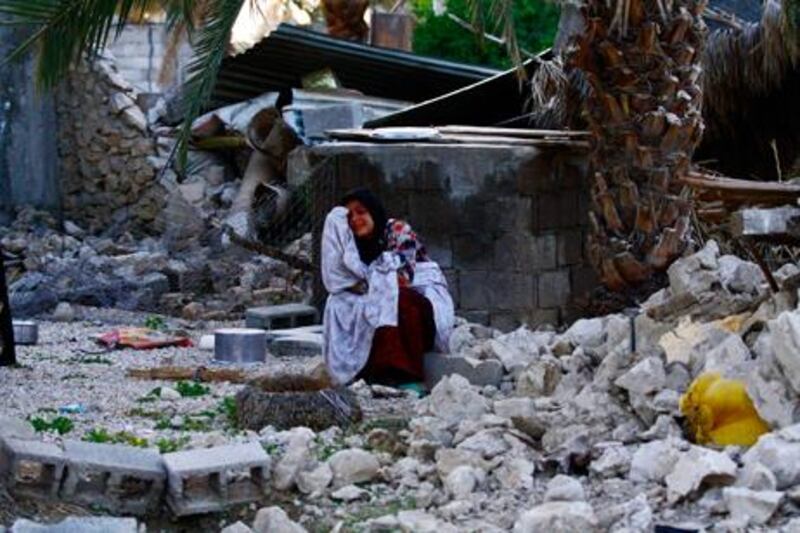DUBAI // High-rise buildings in Abu Dhabi and Dubai were evacuated yesterday amid aftershocks from a 6.2-magnitude earthquake in southwest Iran.
Tremors were felt on Abu Dhabi Corniche, in Abu Dhabi Mall and on Sheikh Zayed Road in Dubai.
Civil defence isued no official warnings or evacuation notices but building managers decided to evacuate their towers.
"It did not last too long but it was enough for us to be shaken," said Ramesh Menon, who was asked to leave his office on the 13th floor of the 17-storey Abu Dhabi Mall building. "It was very scary and there was panic all around. The whole building shook."
Some experts blamed social-media users for spreading panic when there was no cause for alarm. "We are so far away from any potential epicentre, we would only experience mild tremors," said Dr Abdullah Shanableh of University of Sharjah seismic station.
"Before, nobody would know or even notice, now everybody knows almost immediately."
The quake happened at 3.22pm with its epicentre in southern Iran. An earlier tremor was recorded at 11.52am in the same region.
At least 37 people were killed in Iran and 850 injured. Residents of Shiraz, about 500km away from Tehran, were most affected.
It also triggered landslides in Kaki city.
The Bushehr nuclear power plant, 100 kilometres away from the epicentre, continued to function normally.
Reports of mild tremors in the UAE began at about 3.52pm. Faisal Al Saeed, who works in Dubai Media City, said he did not immediately notice the earthquake. "Some people who were in the meeting room came out and said, 'Hey, there's an earthquake!'
"That's when I noticed the lights were swaying and the curtains were moving. I wouldn't say that I felt like I was being shaken but it was a very disorientating feeling."
On Reem Island in Abu Dhabi, residents of the Sun and Sky Towers felt the tremor and left the buildings long before the alarm to evacuate sounded. At about 6pm, the developer Khidmah said Civil Defence had "indicated people may return to their buildings".
In Dubai, several high-rise buildings were evacuated along Sheikh Zayed Road, in Tecom and Dubai Media City, and in Dubai Silicon Oasis.
The UAE is prone to experiencing the aftershocks of Iranian earthquakes because of its proximity to the Zargos Fault in the south of Iran.
Dr Abdel Rahman Fowler, professor of structural geology and tectonics at United Arab Emirates University, said earthquakes occurred frequently in Iran and the tremors felt here should not be a cause for alarm.
"They are at the plate edge and UAE is not," he said. "There has never been any noticeable damage recorded in the past because of earthquakes in Iran."
The UAE has several seismic monitoring stations and officials would probably have known about the quake before it happened.
But Dr Fowler said there was no need to put out a alert to the public for earthquakes in neighbouring countries.
"The problem with issuing a warning is that it can backfire and cause unintended anxiety," he said. "With all the records we have so far, we do not need to elevate the response to this."
Dr Shanableh said Iran had always been a major source of seismic activity in the region, but never one the UAE needed to worry about.
He believed social media was to blame for spreading a sense of panic and advised residents to exercise caution instead of jumping on the bandwagon.
"You have to remember we are hundreds of kilometres away and these waves must travel through rock to reach us," he said.
"Another thing to remember is that we have building codes here now to fortify our towers to resist earthquakes.
"We need to educate people not to panic because this is more dangerous than the seismic risk itself. Every study I have seen on the UAE classifies us as a low-risk area, even the Northern Emirates which is closer to Iran."
However, Arabian Gulf states have long been concerned about safety measures at Bushehr, which is in an earthquake zone at the juncture of three tectonic plates. The Iranian reactor is closer to Abu Dhabi than it is to Tehran.
The Russian company that built the power plant insisted it was designed to withstand far more powerful tremors, and suffered no damage. "Personnel continue to work in the normal regime and radiation levels are fully within the norm," an official at Atomstroyexport said. Iranian officials offered similar assurances.
aahmed@thenational.ae
* Additional reporting by Michael Theodoulou
Earthquake: 37 dead and 850 injured in Iran by tremor that rocked UAE
High-rise buildings in Abu Dhabi and Dubai were evacuated amid aftershocks from the 6.2-magnitude earthquake in southwest Iran.

Editor's picks
More from the national





